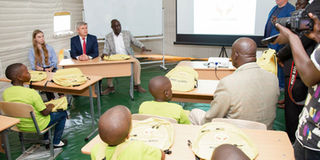Prime
Could mobile schools be what we need?

Daria Nasonovkaya (Left) , the ambassador of Russia H.E Alexander Polyakov and minister, Musa Ecuweru during a meeting in a moblie school tent.
What you need to know:
In some parts of the country, when it rains, school is put on hold because roads and bridges are washed away and learners are left stranded. Sometimes school structures are destroyed too. How much can a mobile school tent help in such instances?
The school term is usually affected by weather patterns and to be more specific, the rainy season. In some parts of the country, when it rains, roads flood, schools become inaccessible for some students and for those who study under trees or in less than desirable structures, shelter is destroyed. For these displaced students, classes have to be put on hold until the rain stops or a solution is found.
In 2015, school blocks of a number of schools including Kijjumba, Ngoma, Kinoni and Kirinda primary schools in Nakaseke were destroyed by rain. Last year in October, rain washed away a bridge on a road that links Kayunga to Mukono District. Because of this, students from Kasawo sub-county, who study from schools in Ntunda Sub-county, Mukono such as BLK Muwonge Senior Secondary School, Central Standard Secondary School and Kyabazaala Public Primary School, could not access their schools.
The same incidents have continued to occur in different parts of the country, but without lasting solutions.
Reaching out
Listening to such occurrences and considering the number of children that are displaced and miss school every time it rains, Daria Nasonovskaya a 17-year-old Russian with support from her family was moved to donate a mobile school to Uganda.
Nasonovskaya says, “We chose Uganda because of the country’s exemplary role in providing safe refuge to displaced persons.”
The mobile school was handed over to the Minister of Disaster Preparedness and Refugees Musa Ecweru in December 2019 at Nyange Marine Resort, Bweranga. Nasonovskaya hopes this tent will be used to change the narrative.
While receiving the tent, Minister Ecweru said the mobile school tent initiative will help children, especially those in candidate classes continue with their classes during calamities such as extreme weather conditions.
“This mobile school is portable and can easily be assembled. It will serve as a classroom stationed at the most affected area. However, my team and I will have to decide on which will it will serve first,” Ecweru noted adding that an evaluation would be conducted in the first quarter of the year to assess the modus operandi of the tents use.
According to Ecweru, with such an initiative, children displaced by calamities can salvage some of the school time lost.
Ecweru wishes Alexander Igatenko the CEO of centre pro, a Russian company that manufactured the tent would sell some to the country, and also train Ugandans on how to make them.
“This will help us have access to more mobile school tents at a cheaper cost,” Ecweru added.
About the mobile school
The mobile school came with a full set of equipment; desks, chairs, blackboards and briefcases. The school that is housed in a tent has all the basic requirements of a normal school. It is water poof with a couple of generator powered lights to add some warmth. It has an inbuilt air conditioner, chairs, tables and whiteboards.
With support from her friends and family, who thought the idea of a mobile school tent will help solve the problem of children missing school due to natural calamities.
She says her aim in this is to ensure that no child misses school. However, this will depend on the arrangements made by the teachers since the tent cannot accommodate an entire school.
“The tent targets approximately 40 children and I thought this would be the starting point to fight for education. I believe every child has a right to education,” she remarked.
This initiative is a good move and with genuine commitment, education can be taken to areas where access to education is difficult.
WHAT IS A MOBILE SCHOOL
Mobile school tents are portable school structures that can be shifted from one place to another. These are commonly used in communities affected by natural calamities such as extreme weather conditions, war among others. These tents remain in place until the calamity is over. These can also be used in areas occupied by the nomadic pastoralists and such schools can only be taken down when the migrants move back to their original habitat.


